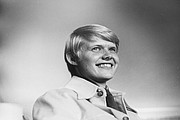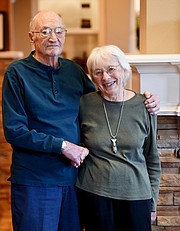Life on campus in FVCC's early years
By KATHERYN HOUGHTON
Daily Inter Lake
On her first day of college, Lois McClaren looked around her English classroom. She spotted a few other nontraditional students shifting in their seats— people who had raised families, worked and lived in Kalispell their entire adult lives.
“It’s a time that I think so many of us didn’t think we’d ever see,” McClaren said, 50 years after she enrolled as part of the first cohort at Flathead Valley Community College. “I was a little bit leery of going. I was almost 40 and thought maybe I couldn’t do it.”
It was 1967. And the wave of communities establishing colleges across the nation had arrived in Kalispell.
Community colleges became a national network in the 1960s with 457 new facilities opening to students — that outnumbered the total in existence before that decade, according to the American Association of Community Colleges.
McClaren was a mother of four and — like many of the college founders’ spouses — she partnered with her husband Bill McClaren to gain community support for higher education in the Flathead. Bill went on to become a dean and vice president of the college. Lois had a different ambition: She decided she wanted to experience life as a student.
To make it feel like less of a leap, McClaren limited herself to one class during the college’s inaugural semester.
The first few weeks of classes, McClaren said, her husband or kids often found her asleep at the kitchen table folded across her textbooks.
“But then I got used to it, and it became addictive. With so many interesting classes, I kept picking up more classes,” she said. “You could do it — that was the feeling in the classrooms.”
There were only a handful of nontraditional students on the ramshackle campus that spread across various rooms and buildings in downtown Kalispell.
“But that didn’t matter, everyone got along well,” she said. “We had so much support, in the community and in the classrooms.”
The Flathead Valley residents who voted for the creation of a college in 1967 were sold on the idea of education within reach for their future generations.
But news of FVCC’s creation brought more than just locals to the Kalispell campus.
AS McCLAREN continued classes as a full-time student in 1969, Joe Toth was adjusting to life in Kalispell.
Toth grew up in the small town of Hot Springs, Montana. The cultural shift of the 1960s and 1970s felt distant until he arrived in Kalispell.
“Young men had long hair, all the music on the airwaves changed — there was talk around civil rights, women’s rights, environmental issues,” Toth said. “School being an academic center gave a forum for a lot of those issues to come up.”
Veterans returning from Vietnam entered FVCC through the GI Bill. Some FVCC students were there for trade school while others were collecting credits to transfer.
Toth said there wasn’t pressure to take classes narrowed to a degree. He joined the student newspaper and enrolled in classes like ceramics. He took drama courses in the old Elks building during the week. On weekends, he stood on the second-floor balcony overlooking the Elk’s wooden stage as local bands experimented with rock and blues.
As headlines announced changing times, there was a feeling of openness on campus.
“It was a haven,” Toth said. “You knew you could come and discuss things — talk about things happening in the world that other people didn’t want to talk about.”
But there was some community push-back.
Or as Toth explained, “If your hair was long, there were certain taverns you would not go into in the valley.”
“Students were flipped off on occasion and people would say things like ‘dope-smoking hippies in our valley.’ It was very educational,” Toth said.
He described the environment in Kalispell during the college’s early years as “natural tension due to changing times.”
A 1971 edition of the Daily Inter Lake that ran the results of an FVCC community survey seemed to verify that statement.
The survey acknowledged that “some of the unusual dress and hairstyles of today’s youth” were offensive to valley residents.
One survey question asked, “Do you believe that FVCC students are, on the whole, basically an asset to our community?”
In response, 74 people said “no” while 273 said they agreed the students were basically an asset.
IVAN Lorentzen began teaching at FVCC the same year the survey was released. He said by the time the 1970s rolled into place, the atmosphere within the FVCC faculty was adventurous and experimental on-campus and hesitant off-campus.
“We were pioneers; we were creating something from nothing. Everything was to be figured out and imagined and created,” He said. “However, from the community perspective, the popularity of the college was very bad.”
There were just more than 30 full-time faculty members serving a growing student body in 1971. Lorentzen said the more that people were attracted to FVCC, the more scrutiny the college faced from some local residents.
“Part of it was, ‘who are these students this place is attracting?’ Part of it was an urban legend that the college promised it would never cost any money,” he said. “For years when people asked you ‘where do you work,’ you did not want to say ‘FVCC.’”
The college was very much a homegrown institution. According to the 1971 survey, 90 percent of FVCC students were from the Flathead Valley, 8 percent were Montanans who traveled to the Flathead and the remaining 2 percent were from another state.
“But to a lot of people, the diversity that did arrive on campus was alarming,” Lorentzen said. “It took a while to build that community trust.”
Lorentzen was 23 and harvesting on his parents’ farm in Creston when his mom came to him with a message that the college had called.
After earning a bachelor’s degree in psychology and master’s degree in physiological psychology at Montana State University, Lorentzen had returned home to find a job.
The week before classes began, Lorentzen was one of two FVCC professors hired with federal grant dollars.
A rookie in the field, Lorentzen was surrounded by early FVCC faculty who had given up stable positions to be part of the college’s beginning.
“We had no culture, no expectations, it was ‘get in there and do your job as a teacher,’” he said. “In the meantime, the administration was busy just trying to figure out just how to make the place survive.”
He said early administrators focused on writing grants, recruiting students and creating low-cost programs with high student ratios like English, which simply needed a chalkboard.
He said as the college has stabilized in recent decades, it’s grown to offer more niche programs like welding and nursing.
Eventually, he and the rest of the faculty felt secure that the college was here to stay.
In 2016, Lorentzen retired from FVCC as the longest standing faculty member with roughly 45 years at the college.
Throughout his time at FVCC, Lorentzen watched the campus shift from typewriters to computers; from downtown to its current home off U.S. Highway 93; and from a controversy to a community bragging right.
“Being part of something that was being created from scratch provides a perspective that people coming in 20 or 30 years into the machine really don’t understand,” he said.
As for the college’s future, Lorentzen said he think it’s in good shape.
“There are always things to do, to improve, to change. And I would hope that on the one hand the college is never satisfied,” he said. “On the other hand, I think the college needs to be able to recognize a great deal of satisfaction about what’s been created over the last 50 years.”
Reporter Katheryn Houghton may be reached at 758-4436 or by email at khoughton@dailyinterlake.com.








